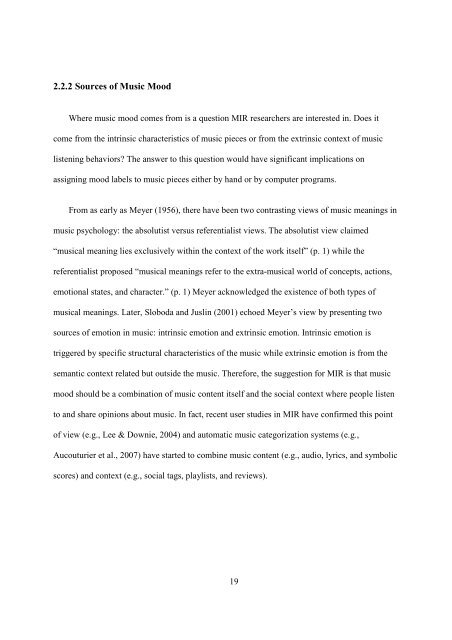improving music mood classification using lyrics, audio and social tags
improving music mood classification using lyrics, audio and social tags
improving music mood classification using lyrics, audio and social tags
You also want an ePaper? Increase the reach of your titles
YUMPU automatically turns print PDFs into web optimized ePapers that Google loves.
2.2.2 Sources of Music Mood<br />
Where <strong>music</strong> <strong>mood</strong> comes from is a question MIR researchers are interested in. Does it<br />
come from the intrinsic characteristics of <strong>music</strong> pieces or from the extrinsic context of <strong>music</strong><br />
listening behaviors? The answer to this question would have significant implications on<br />
assigning <strong>mood</strong> labels to <strong>music</strong> pieces either by h<strong>and</strong> or by computer programs.<br />
From as early as Meyer (1956), there have been two contrasting views of <strong>music</strong> meanings in<br />
<strong>music</strong> psychology: the absolutist versus referentialist views. The absolutist view claimed<br />
“<strong>music</strong>al meaning lies exclusively within the context of the work itself” (p. 1) while the<br />
referentialist proposed “<strong>music</strong>al meanings refer to the extra-<strong>music</strong>al world of concepts, actions,<br />
emotional states, <strong>and</strong> character.” (p. 1) Meyer acknowledged the existence of both types of<br />
<strong>music</strong>al meanings. Later, Sloboda <strong>and</strong> Juslin (2001) echoed Meyer’s view by presenting two<br />
sources of emotion in <strong>music</strong>: intrinsic emotion <strong>and</strong> extrinsic emotion. Intrinsic emotion is<br />
triggered by specific structural characteristics of the <strong>music</strong> while extrinsic emotion is from the<br />
semantic context related but outside the <strong>music</strong>. Therefore, the suggestion for MIR is that <strong>music</strong><br />
<strong>mood</strong> should be a combination of <strong>music</strong> content itself <strong>and</strong> the <strong>social</strong> context where people listen<br />
to <strong>and</strong> share opinions about <strong>music</strong>. In fact, recent user studies in MIR have confirmed this point<br />
of view (e.g., Lee & Downie, 2004) <strong>and</strong> automatic <strong>music</strong> categorization systems (e.g.,<br />
Aucouturier et al., 2007) have started to combine <strong>music</strong> content (e.g., <strong>audio</strong>, <strong>lyrics</strong>, <strong>and</strong> symbolic<br />
scores) <strong>and</strong> context (e.g., <strong>social</strong> <strong>tags</strong>, playlists, <strong>and</strong> reviews).<br />
19
















